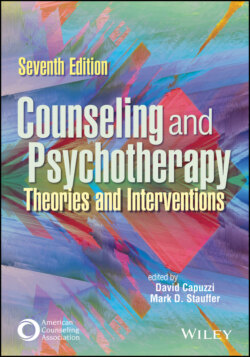Читать книгу Counseling and Psychotherapy - Группа авторов - Страница 140
Brief Intervention Strategies Brief Psychodynamic Theory
ОглавлениеTraditional psychoanalytic theory focuses on unconscious processes as they are manifested in the client’s present behavior. Psychodynamic approaches additionally emphasize client self-awareness and understanding of the influences of the past on present behavior, and the correction of the client’s distortions is often the primary focus of therapeutic treatment (Thomas, 2008). In its brief form, a psychodynamic approach enables the client to examine unresolved conflicts and symptoms that arise from past dysfunctional relationships that manifest themselves in maladaptive needs and desires. The primary goal is to estimate what may have happened in the past that created a current issue. There is generally one major focus in the sessions, and although free association is not used so that the generation of additional topics is avoided, clients are still encouraged to explore issues that have tangential relation to the primary problem (Haggerty, 2013).
The two primary aims of this approach are (a) to help the client understand the connection between their presenting symptoms and what is happening in their relationships by identifying a core, unconscious, repetitive pattern of relating that becomes the focus of the therapy; and (b) to encourage the client’s capacity to reflect on their own state of mind and so enhance their ability to manage interpersonal difficulties. The counselor assumes that changes will happen rapidly and that a short intervention will begin a long change process that continues beyond counseling. The number of sessions varies from one approach to another, but brief psychodynamic counseling relies on the estimated time that is needed to achieve the counseling goals as determined at the beginning of counseling and generally does not extend beyond 16 sessions (Lemma et al., 2011).
The brief psychodynamic approach is conceptualized in three phases. In the initial phase, the client is engaged in the counseling process, and by providing structure, direction, and confrontation, the counselor engages the client in assessing current difficulties and defenses. In the middle phase, the counselor focuses on one problem or pattern, and, using a variety of interpretation methods, such as dynamic interpretation, resistance interpretation, transference interpretation, or dream interpretation, the client develops an awareness of the presentation of symptoms related to the identified problem. In the ending phase, the counselor and client cooperatively review the material, evaluate progress, and transition toward the end of treatment by focusing on the conscious and unconscious meaning of separation from the counselor following termination (Lemma et al., 2011).
Psychodynamic counseling generally involves developing a therapeutic alliance and addressing defense mechanisms and intrapsychic conflicts in an attempt to show the multiple conscious and unconscious factors that influence a client’s symptoms and behaviors. A current example of psychoanalytic evolution is the introduction of psychodynamic interpersonal therapy and interpersonal psychotherapy. Each approach has a basis in classical psychoanalysis but can be applied in a brief context and has a specific set of techniques that uniquely define it.
